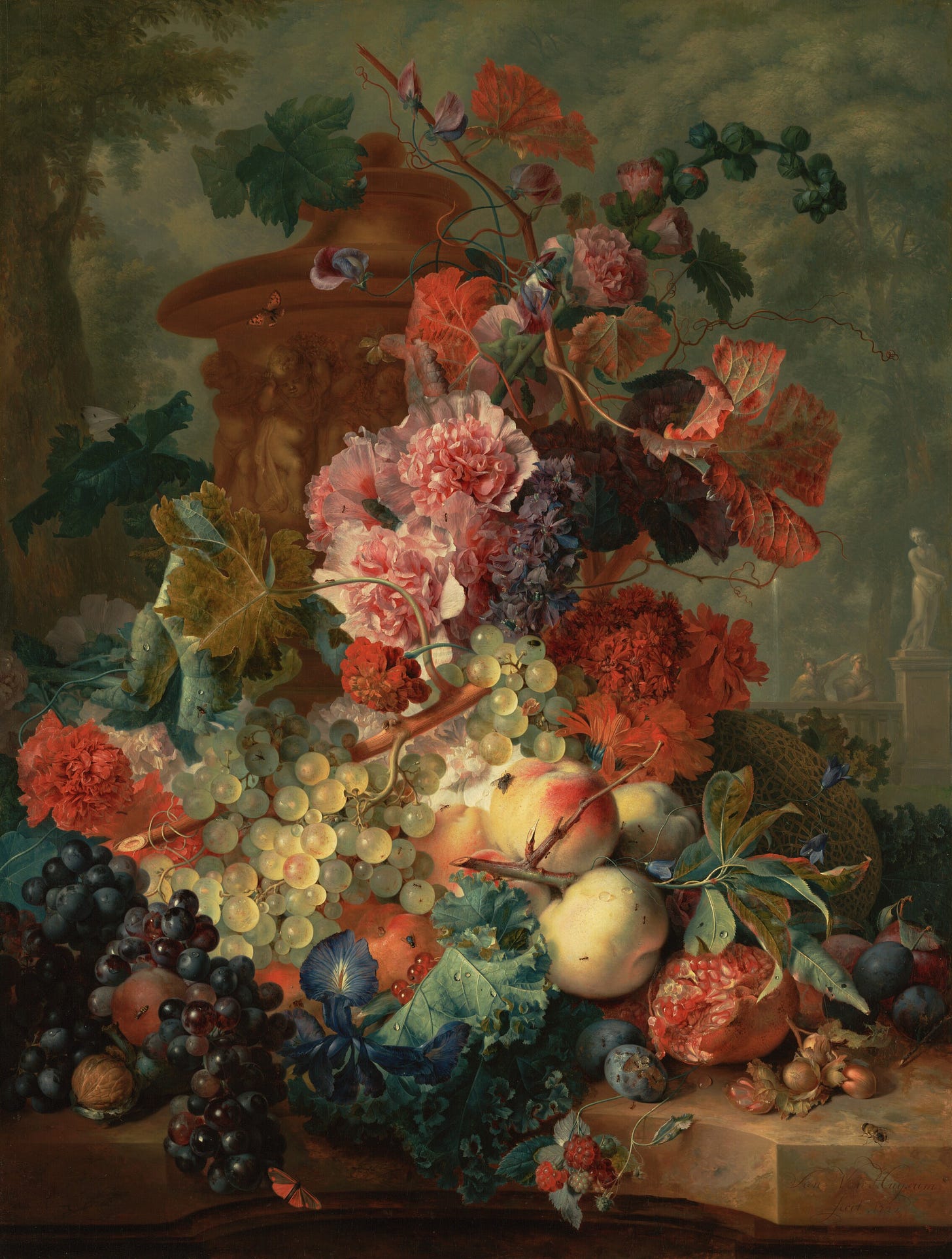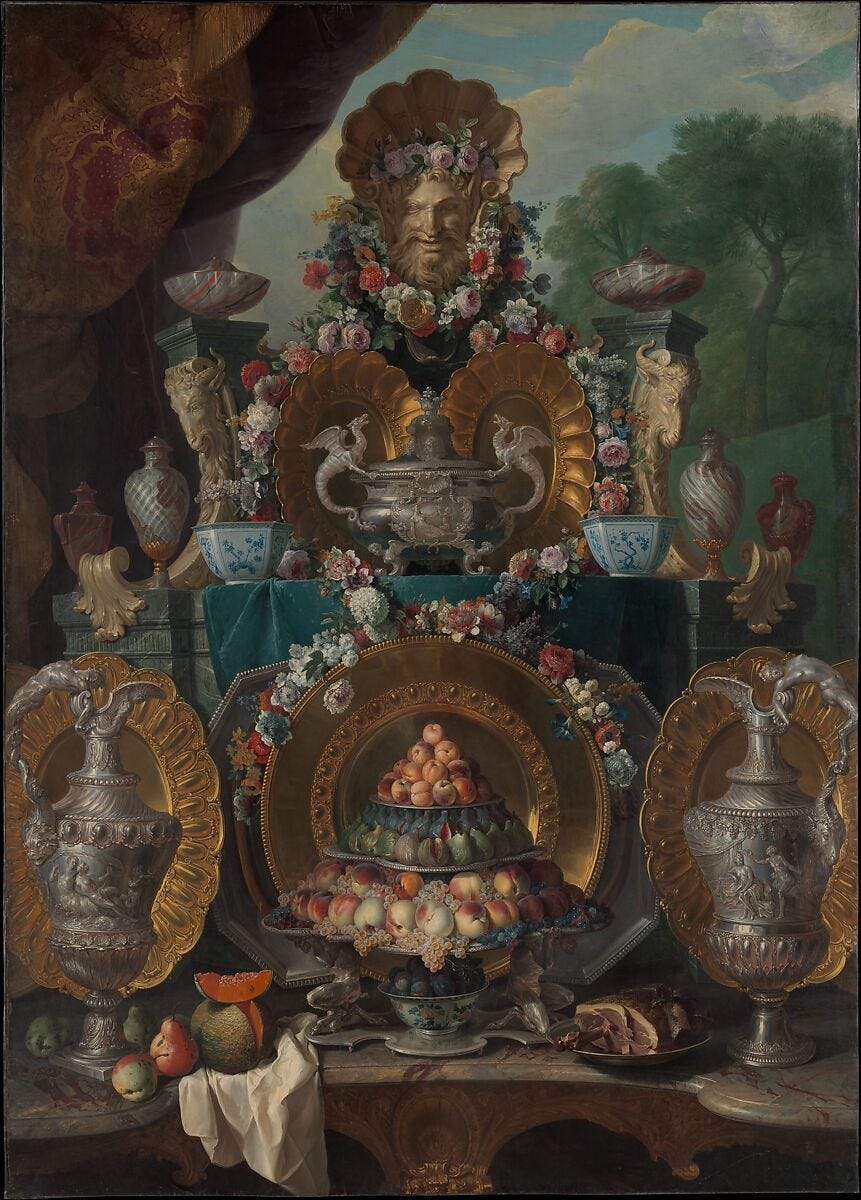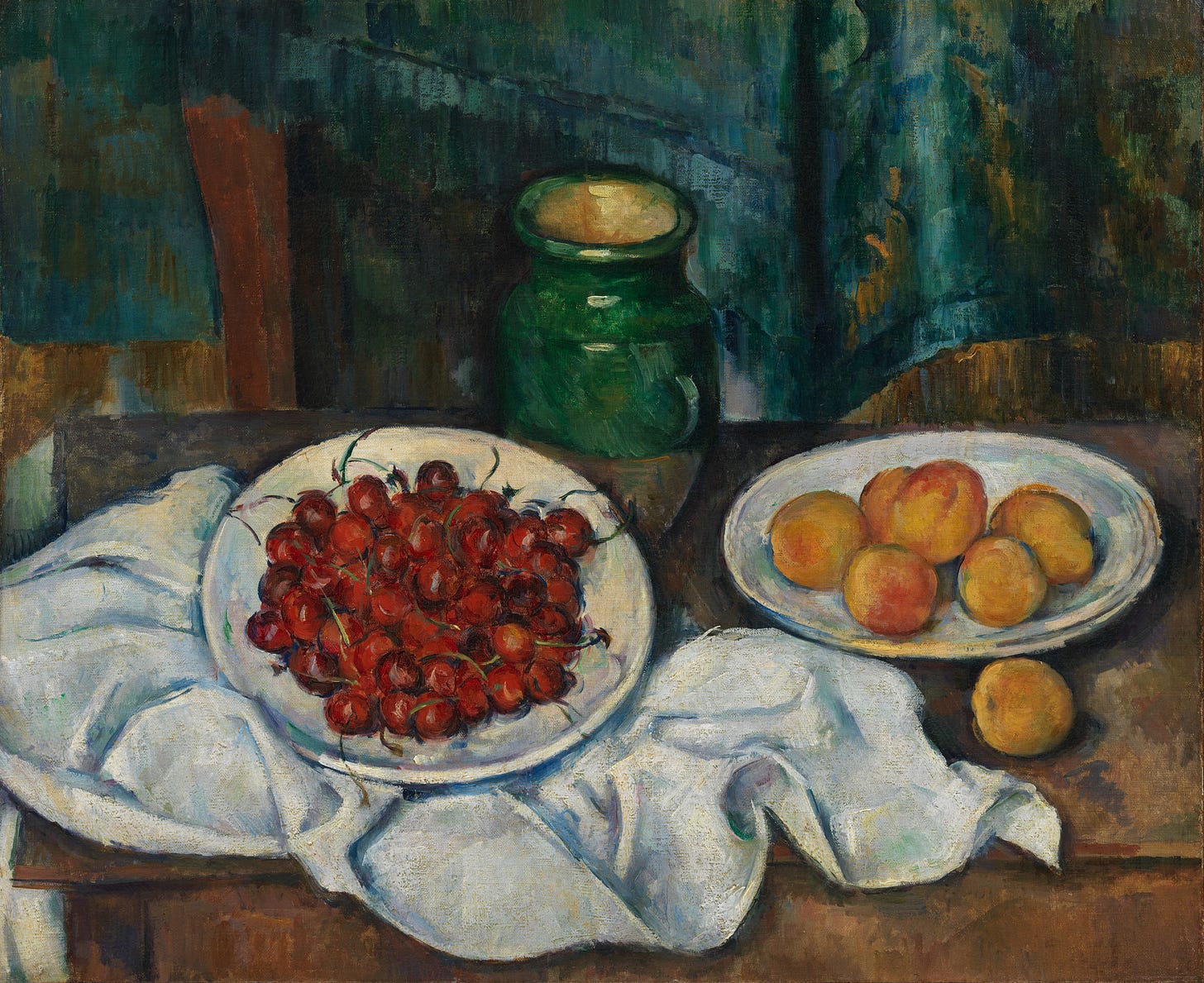Welcome to this week’s edition of Reading Art!
This week on my lunch break I went to visit Getty’s “A Brush with Nature: Romantic Landscape Drawings.” Landscapes are some of my favorite, and it’s a beautiful exhibition that really makes landscapes come alive. These drawings of nature reminded me, in a way, of still lives: calm and seemingly unmoving yet actually full of life. And then it occurred to me that maybe there really is no such thing as a still life: everything is vibrant. That’s our virtual gallery tour topic for today: the secret world within the still life.
Speaking of Getty, this is one of my favorites to go visit on an art break to get away from my laptop and go look at something beautiful:

It’s an eighteenth-century work by Jan van Huysum, who was famous for his unique process of glazing his canvases, which gives the paintings a glassy, shimmering quality that you can even see in a photograph of the work. I love the way the grapes have a glasslike quality to them (are they fake or real?) and how the yellow of the peaches catches the light and contrasts against the rosy hue spreading over them as they ripen.
In the background, there seems to be some classical-style architecture, with little cupids carved in marble appearing to hold up the top of the work. The setting starts so subtly—your eye catches the flowers and the fruit first—and then it raises the question: what’s the context of the still life? Is it part of a banquet, awaiting joyful partygoers? Who picked the flowers, who arranged the fruit? The longer you look, the more a story starts to unfold in your imagination.
This still life is from the same time period, but comes from France, by Alexandre François Desportes:

The peaches have the same brightness to them, reflecting off the extensive silver and gold serving ware that gives the scene its foundation, allowing the flowers and the fruit to cascade down like a waterfall. My eye wants to land on the cut melon at the bottom left.
Desportes worked for Kings Louis XIV and Louis XV, and his work reflects the high degree of luxury expected for a king.
I would love to know the identity of the figure at the top of the scene. I wonder if it’s meant to be a Greco-Roman god, especially with the other classical motifs present on the silver and gold. Maybe he’s Saturn/Cronus, the god of abundance, discipline, and possibly time. Maybe he’s Vertumnus or Priapus or Bacchus or some other god of nature/fertility/agriculture. Maybe there’s supposed to be a suggestion that the French king is like the god in this scene, implying that he’s the ruler who is responsible for the good fortune of all around him.
In both of these scenes, the indoor/outdoor juxtaposition suggests not only that art imitates nature, but that nature also begins to imitate art, making architectural structures all around the subjects of the still lives.
The opulent works above are endlessly fascinating to look at, but I’m also drawn to a simpler, more everyday aesthetic. Fruit in particular is such an appealing subject for a still life, even in works created centuries apart. I love the simplicity of this one, by French Impressionist painter Paul Cézanne:

Unlike Jan van Huysum’s lustrous grapes, Cézanne’s have a roughness to them that is somehow just as appealing. It captures the fuzziness of a peach really well, but somehow renders the cherries more raw or unfinished than they appear in real life, contrasting with the smooth, glasslike exterior of the vessel on the table. The further back you stand, though, the more and more the textures of the three objects seem to become similar, and you can’t tell if the fruit becomes smoother, like the ceramic, or if the ceramic becomes rougher looking, like the fruit. They all exist as one.
To me, this scene evokes a simple breakfast on a summer morning. The scene is only motionless because it takes place in the moments before the breakfast starts. But the scene has its own dynamism too; the rumpled linen under the cherries speaks to a fruit bowl hastily placed down, with no time to smooth it out. Perhaps a busy day is ahead of the unseen character in this work, the person about to sit and eat the cherries and the peaches. Or maybe there’s more than one person, a family, or a group of friends, a pet or two waiting to get a taste of the peak-of-the-season-peach.
Still lives are ubiquitous across cultures and eras, in works famous and largely undiscovered. I was flipping through the Met’s collection, and this woodblock print with ink on paper from the Edo period caught my eye:

The artist is unknown, which makes it all the more intriguing. The red and white flower in the vase creates a focal point for the scene, while the folds of the booklet give the scene an additional sense of motion. The red beneath could be spilled ink, or tea, or part of a pattern on a tabletop, or just a suggestion of a firm surface beneath. Finally, the box at the end has sketches of five little mice on it (or in it?), a motif of the natural world that is typical for still lives, but also betokens diligence, busyness, industriousness, and possibly even a sense of coziness. I thought about tracking down a translation for the writing, but decided to let that go for another day, since it gives me the opportunity to look at the visual cues in the scene without the benefit of context. For some reason, this still life puts me in mind of the desk of someone with a lot of interests and hobbies. There are endless possibilities for the un-depicted “context” of the scene.
Sometimes the image itself doesn’t give us any additional clues about the setting or circumstances of the still life, but other parts of the work do. One example is a recent piece by Colter Jacobsen, entitled “bouquet for k”:

The title, taken together with the card on the table, gives this still life a very romantic aura. I love how one or two petals has fallen onto the waterlike surface of the table (loves me not, loves me, loves me not, loves me). What’s written in the card? Is it a love letter? The assonance and false alliteration of “bouquet for k” adds an additional feeling of poetic beauty to that single title. Who is k? Is it someone important to the artist in real life? Or is k a character, imagined for the setting of this lovely scene? It could be any of these possibilities, or as many as one can imagine.
Thank you for reading this week’s newsletter!
Still lives are everywhere around us. This week, take a look at your desk, your nightstand, your kitchen table, your refrigerator, or anywhere around you, really, and see what story the collection of objects sitting there start to tell. It’ll be part of the story of your life—a still life, perhaps, but not a motionless scene.
I hope you enjoyed this week’s virtual gallery tour! Take care until next time.
MKA



